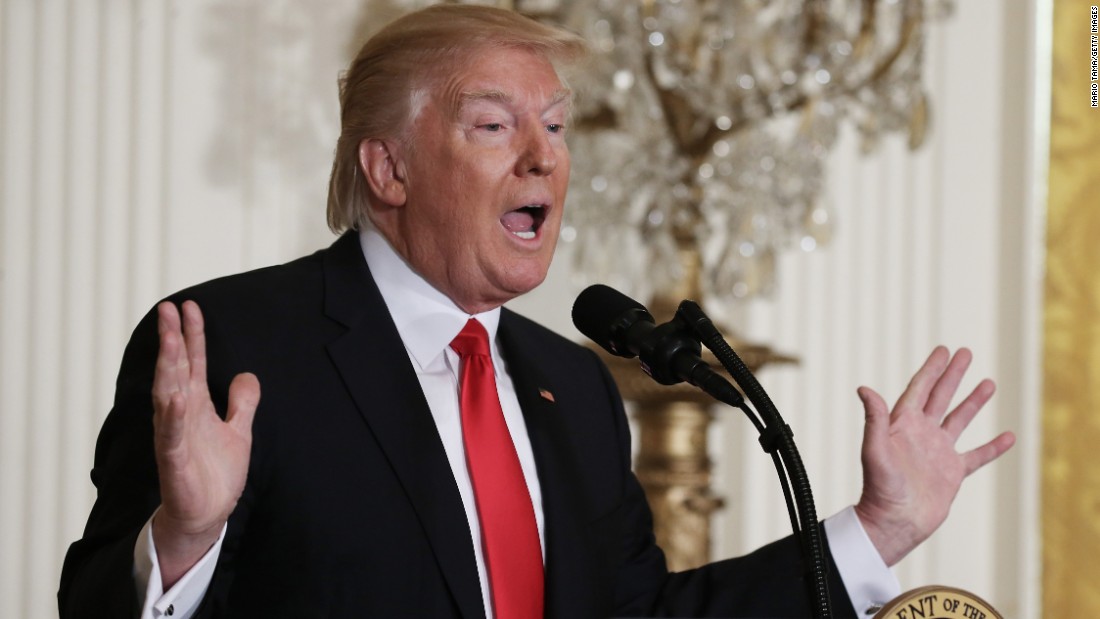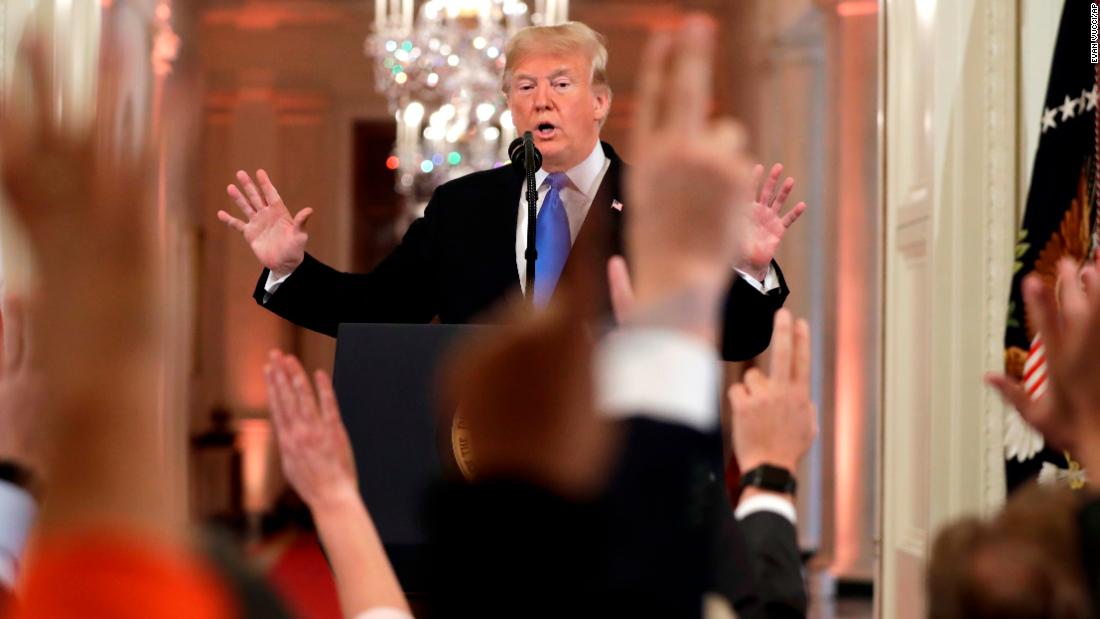Trump’s Press Conference Style and Tactics: Trump Press Conference

Donald Trump’s press conferences were a spectacle unlike any other in modern American politics. His unique style, marked by a blend of bombast, theatrics, and a direct appeal to his base, became a defining characteristic of his presidency.
Use of Rhetoric and Language
Trump’s language was often blunt, colloquial, and prone to exaggeration. He employed a populist style, using simple, declarative sentences and avoiding complex arguments. He frequently used hyperbole, repetition, and personal attacks to make his points.
“We’re going to build a wall, and Mexico is going to pay for it.”
This statement, repeated throughout his campaign and presidency, became a rallying cry for his supporters and a source of ridicule for his detractors.
Common Communication Strategies
Trump’s communication strategies were often designed to generate attention and provoke a reaction.
- Repetition: Trump frequently repeated key phrases and slogans, aiming to imprint them on the public consciousness. His use of repetition served to reinforce his message and create a sense of urgency.
- Personal Attacks: Trump often resorted to personal attacks against his opponents, both in the media and in the political arena. These attacks were designed to discredit his adversaries and distract from his own shortcomings.
- Appeals to Emotion: Trump appealed to the emotions of his supporters, often using fear, anger, and patriotism to rally them behind his cause. He employed a narrative of American decline and promised to “Make America Great Again.”
Comparison to Previous Presidents
Trump’s press conference style differed significantly from that of his predecessors. While presidents like Barack Obama and George W. Bush often engaged in more measured and nuanced communication, Trump favored a more confrontational and theatrical approach. His press conferences were often characterized by shouting matches with reporters, personal attacks, and a disregard for established norms.
Impact on the Public and the Media
Trump’s communication style had a profound impact on both the public and the media. His supporters praised his honesty and directness, while his critics condemned his divisive rhetoric and lack of civility. The media, often caught in the crosshairs of his attacks, struggled to maintain objectivity and provide fair coverage.
The Content of Trump’s Press Conferences

Donald Trump’s press conferences were often marked by their unconventional nature, deviating significantly from the traditional format and content of his predecessors. While his press conferences were frequently characterized by their theatricality and the President’s tendency to engage in personal attacks and inflammatory rhetoric, the content itself also held significant implications for the political landscape.
Key Topics Discussed
Trump’s press conferences covered a wide range of topics, but certain themes consistently emerged. These included:
- The Economy: Trump frequently touted the strength of the US economy, often citing low unemployment rates and stock market gains as evidence of his administration’s success.
- Immigration: Immigration was a central focus of Trump’s presidency, and his press conferences often featured discussions about border security, the construction of a wall along the US-Mexico border, and the separation of families at the border.
- Foreign Policy: Trump’s press conferences often addressed issues related to foreign policy, including trade deals, military actions, and relations with other countries.
- The Media: Trump frequently criticized the media, accusing them of bias and spreading “fake news.”
- His Political Opponents: Trump frequently attacked his political opponents, including members of the Democratic Party, the media, and other critics.
Relationship to Current Events
The content of Trump’s press conferences often reflected the major events and issues of the day. For instance, during the COVID-19 pandemic, his press conferences focused heavily on the virus, his administration’s response, and the economic fallout. Similarly, his press conferences during the 2020 election campaign centered on election integrity, voter fraud allegations, and his claims of victory.
Shaping Public Opinion and Policy
Trump’s press conferences played a significant role in shaping public opinion and policy. By directly addressing the public, he could bypass traditional media outlets and control the narrative surrounding key issues. His pronouncements often set the agenda for the news cycle, and his attacks on his opponents could influence public perception. Additionally, his press conferences provided a platform for him to promote his policy agenda and pressure Congress to act on his priorities.
Comparison with Predecessors, Trump press conference
Compared to his predecessors, Trump’s press conferences were characterized by a greater focus on personal attacks, a more adversarial relationship with the media, and a more direct appeal to the public. His predecessors typically held more formal press conferences, adhering to a more structured format and emphasizing policy announcements over personal attacks. While Trump’s predecessors also engaged with the media, their interactions were generally more professional and less confrontational.
The Media’s Coverage of Trump’s Press Conferences

The media’s portrayal of Donald Trump’s press conferences has been a topic of intense scrutiny and debate. The highly charged nature of Trump’s presidency, coupled with his confrontational style, has led to a media landscape where coverage of his press conferences often reflects a deep partisan divide.
The Tone and Framing of Media Coverage
The media’s coverage of Trump’s press conferences has been characterized by a range of tones, from highly critical to more neutral. Some media outlets, particularly those with a perceived liberal bias, have tended to focus on Trump’s rhetoric, his attacks on the media, and his perceived falsehoods. They often frame his press conferences as opportunities for him to spread misinformation and sow discord. Conversely, outlets perceived as conservative have often presented a more favorable view of Trump’s press conferences, highlighting his policy pronouncements and his direct communication style.
The Impact of Media Coverage on Public Perception
The media’s coverage of Trump’s press conferences has undoubtedly influenced public perception of his presidency. Studies have shown that people tend to rely on news sources that align with their existing political views, reinforcing pre-existing beliefs and creating echo chambers. This phenomenon has contributed to the polarization of American politics, with people often receiving conflicting narratives about Trump’s press conferences depending on their preferred media outlets.
Comparison with Coverage of Previous Presidents’ Press Conferences
The coverage of Trump’s press conferences differs significantly from the coverage of previous presidents’ press conferences. While past presidents have also faced criticism and scrutiny, the level of hostility and the pervasiveness of negative coverage directed at Trump have been unprecedented. This can be attributed to a number of factors, including the highly polarized political climate, Trump’s confrontational style, and the rise of social media.
The Role of Social Media
Social media has played a significant role in shaping public opinion on Trump’s press conferences. Twitter, in particular, has become a platform for both supporters and critics of Trump to share their views and engage in debates. Social media algorithms often prioritize content that is provocative or controversial, amplifying the reach of negative or positive narratives about Trump’s press conferences. This has contributed to the spread of misinformation and the creation of echo chambers, further polarizing public opinion.
Trump press conference – Trump’s press conferences were often unpredictable, a whirlwind of pronouncements and pronouncements. You never knew what bizarre claim would be made next, like the time he suggested injecting bleach to cure COVID-19. It was almost like a bizarre, live-action version of “Beetlejuice,” where you just had to say the name three times and a chaotic event would unfold.
And just like the iconic “Beetlejuice Beetlejuice Popcorn Buckets” beetlejuice beetlejuice popcorn buckets , his press conferences were a cultural phenomenon, leaving you both entertained and bewildered.
Trump’s press conferences were often unpredictable, a whirlwind of pronouncements and pronouncements. While the media focused on the spectacle, there were often quieter stories happening behind the scenes. Take, for instance, the story of Gwen Walz , Minnesota’s First Lady, who quietly worked to promote literacy programs during the Trump administration, a testament to the power of quiet action amidst the noise.
Even in the chaos of a Trump press conference, there were always stories to be found, stories that often had a more lasting impact than the headlines.
